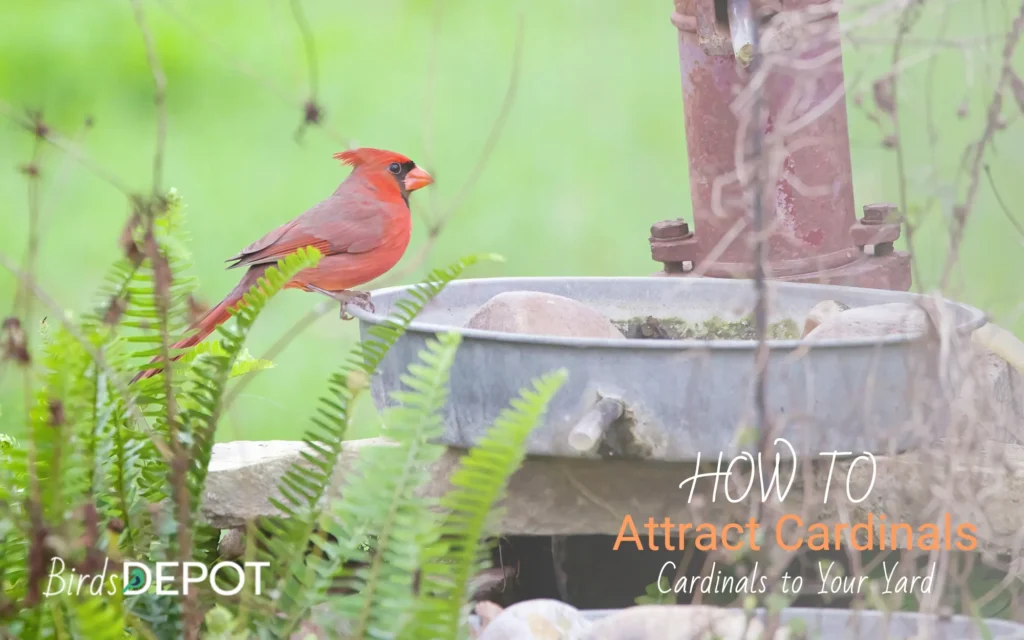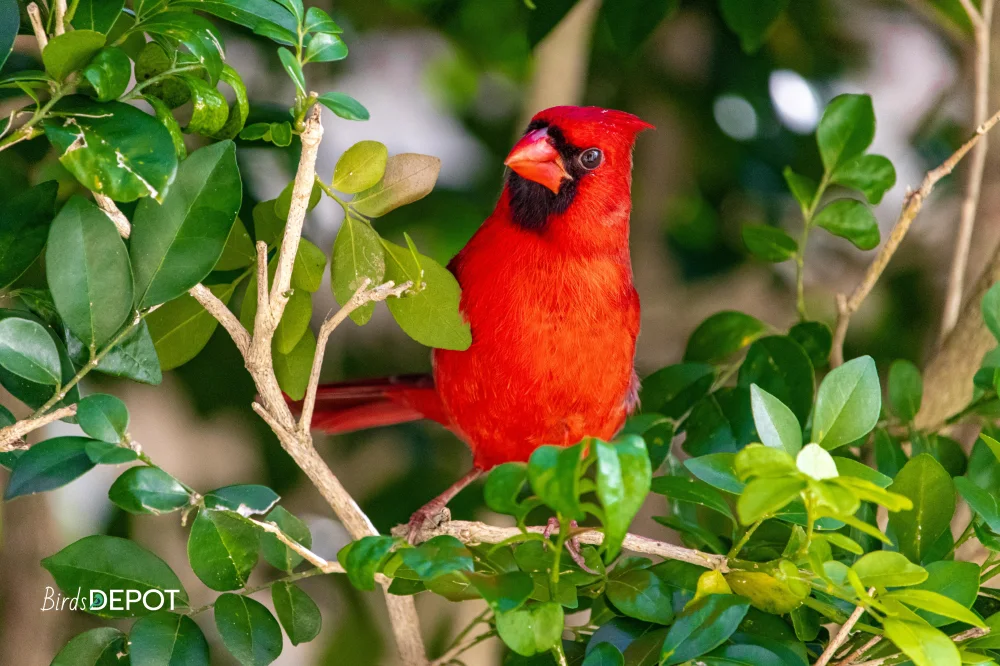How to Attract Cardinals to Your Yard: Ultimate Guide

Fortunately for bird darlings, Cardinals are easy to please. With a couple of basic changes to your lawn and bird feeder setup, your yard could soon turn into a shelter for these darling birds. Cardinals do not migrate, allowing you to enjoy their presence throughout the year.
With an estimated breeding population of 120 million across North America, Northern Cardinals are beloved backyard visitors that can bring year-round color and joy to your outdoor space. These stunning birds primarily inhabit woodlands, gardens, shrublands, and wetlands throughout the eastern United States, parts of Canada, and as far south as northern Mexico and Central America.
In this blog post, I’ll share proven strategies to transform your yard into a cardinal haven that will keep these beautiful birds returning season after season.
12 Easy ways to attract cardinals to your yard
1. Select the Right Cardinal Feeder
Cardinals aren’t just any backyard visitor – they have specific preferences when it comes to feeders. As medium-sized songbirds, they need space to perch comfortably while eating.
Best feeders for cardinals:
- Platform feeders
- Hopper feeders with wide perching areas
- Ground-level feeding stations
Kingsyard Wild Bird Feeder
Charming design with ample room
3 compartments can be filled with different types of seeds for when you want to attract an even larger variety of birds.
Cardinals are natural ground foragers, so they appreciate stable, open platforms that don’t sway like tube feeders often do. Their portly build requires feeders with bars set back from the feeding trough, giving them ample room to position themselves while dining.
Pro tip: Place feeders 10-12 feet from ground cover to give cardinals a clear view of approaching predators while still allowing them to forage for fallen seeds below.
2. Provide Their Favorite Foods
Once you’ve selected appropriate feeders, filling them with the right food is crucial for attracting cardinals.
Cardinal food preferences:
- Black oil sunflower seeds (their absolute favorite)
- Safflower seeds (bonus: less appealing to squirrels)
- Striped sunflower seeds
- Peanuts
- Cracked corn
- Dried fruits
Wagner's Wild Bird Food
Contains sunflower and general purpose seeds
Deluxe Blend can be used in all types of feeder.
Cardinals have strong, cone-shaped bills perfectly designed for cracking open large seeds. Their distinctive bills make it easy for them to handle substantial seeds like sunflower that smaller birds might struggle with.
3. Create Multiple Feeding Stations
I’ve noticed over years of observation that cardinals can be less aggressive at feeders than other bird species. They sometimes get pushed aside by more dominant birds, which can limit their feeding opportunities.
To increase your chances of attracting more cardinals, set up multiple feeding stations throughout your yard. This simple strategy reduces competition and gives cardinals the option to move to quieter feeders where they can dine in peace.
Albeit low bushes and hedges give them plentiful security, abstain from dissipating seed or putting feeders close to these shrubs. They additionally give hunters the ideal spot to stow away and effectively assault their birds.
4. Add a Splash of Water
A reliable water source is essential for attracting cardinals. Like all birds, they need water for drinking and bathing, making a bird bath near your feeders a powerful cardinal magnet.
Birdbath tips:
- Maintain a depth of 1-3 inches
- Add gentle water movement with a dripper, fountain, or mister
- Change the water regularly and keep it clean
- Consider using deicers in winter and solar fountains in summer
VIVOHOME Garden Bird Bath
subtitle
tagline
Research shows that moving water is particularly appealing to cardinals, as it signals a fresh, clean source. During my years of bird watching, I’ve consistently noticed increased cardinal activity around bird baths with gentle water movement.
5. Create Safe Havens with Shelter and Nesting Spots
Food and water alone won’t make cardinals feel at home. They also require appropriate shelter to feel secure enough to become regular visitors.
Cardinal-friendly shelter options:
- Dense shrubs and trees
- Evergreens
- Dogwoods
- Honeysuckles
These plants provide excellent nesting spots and protection from predators and harsh weather. Cardinals often build multiple nests each season, so including a mix of shrubs at various heights gives them options for each nesting cycle.
I’ve found that creating these protected spaces is essential for drawing cardinals into my yard and encouraging them to stay long-term.
6. Plant Native Berry-Producing Shrubs

Want to go the extra mile in attracting cardinals? Plant native shrubs that produce berries. Cardinals love these natural treats, and native plants provide food sources that these birds instinctively recognize and prefer.
Recommended berry-producing plants:
- Holly
- Serviceberry
- Elderberry
Try to grow a variety of shrubs that produce berries in different seasons to provide these delicious natural treats throughout the year. This strategy not only attracts cardinals but also supports the local ecosystem by maintaining native plant populations.
7. Keep Predators Away
Cardinals are cautious birds with a strong sense of self-preservation. If they detect predators in your yard, they’ll quickly move on to safer territories.
Predator deterrence strategies:
- Keep outdoor cats indoors
- Use baffles on feeder poles to deter squirrels and climbing predators
- Apply deterrent sprays around the area
- Position feeders to allow for quick escape routes
Since cardinals love to search through fallen seeds beneath feeders, placing these stations with good visibility allows them to spot approaching dangers and fly to safety.
8. Ensure a Year-Round Food Supply
Unlike many bird species, cardinals don’t migrate. This means they need consistent food sources throughout the year to remain in your area.
Maintaining well-stocked feeders becomes especially important during winter when natural food sources are scarce. Studies indicate that providing year-round food significantly increases the likelihood of birds returning to your yard.
I can attest to the joy of looking out at a snow-covered landscape and seeing a brilliant red cardinal against the white backdrop. That sight alone makes the effort of maintaining a year-round feeding schedule worthwhile.
9. Make Nesting Materials Available
Female cardinals are responsible for nest building, creating open cup-shaped nests using materials like twigs, weeds, pine needles, grass, and bark. They line these structures with soft plant material for comfort.
Ways to provide nesting materials:
- Leave small twigs and grass clippings inaccessible areas after yard maintenance
- Hang an empty suet cage from a tree branch filled with suitable nesting materials
- Avoid over-cleaning your yard during nesting season
This thoughtful gesture makes it easier for cardinals to find what they need for successful nesting right in your yard.
10. Supply Protein-Rich Food Sources
While seeds make up a significant portion of a cardinal’s diet, they also rely heavily on insects, especially during spring and summer when feeding their young. Caterpillars are a particularly important protein source for cardinal families.
Ways to attract insects for cardinals:
- Plant caterpillar-friendly plants like dill, fennel, parsley, coneflower, milkweed, black-eyed Susan, and aster
- Avoid using pesticides in your yard
- Create insect-friendly habitats with native plants
These practices increase the insect population in your yard, providing essential protein for cardinals and their offspring.
11. Don’t Clean Up Perennials
If you typically prune and clean up perennials at the end of each growing season, consider leaving them standing through winter. These dried plants produce seed husks that provide valuable food for cardinals during the colder months when other food sources are limited.
You can always tidy up before new spring growth begins, but leaving this natural food source available through winter can make a significant difference in keeping cardinals in your yard during the harshest months.
12. Cover Reflective Surfaces
Male cardinals are territorial during the breeding season and fiercely defend their territory against perceived rivals. Unfortunately, this includes their reflections in windows or other shiny surfaces.
Reflection prevention strategies:
- Cover or relocate reflective garden decorations
- Apply window decals or screens to break up reflective surfaces
- Use external window coverings during peak territorial seasons
This simple intervention prevents cardinals from wasting energy fighting non-existent rivals and reduces the risk of injury from collision with windows.
Conclusion: Patience and Consistency
Creating a cardinal-friendly yard takes time and consistency, but the rewards are well worth the effort. By implementing these twelve strategies, you’ll transform your outdoor space into an inviting haven that cardinals can’t resist.
Remember that attracting these beautiful birds is about more than just enjoying their striking appearance – it’s about creating a sustainable environment where they can thrive throughout the year. With patience and dedication to meeting their needs, you’ll soon enjoy the sight of brilliant red cardinals brightening your yard every season.
Have you had success attracting cardinals to your yard? I’d love to hear about your experiences and any additional tips you might have discovered. Share your cardinal stories in the comments, and let’s continue learning from each other’s bird-watching journeys!


